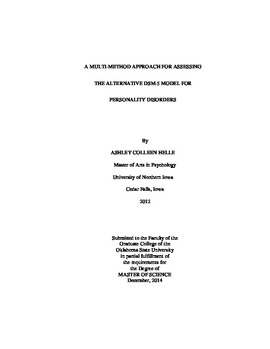| dc.contributor.advisor | Mullins-Sweatt, Stephanie N. | |
| dc.contributor.author | Helle, Ashley Colleen | |
| dc.date.accessioned | 2016-01-20T15:44:36Z | |
| dc.date.available | 2016-01-20T15:44:36Z | |
| dc.date.issued | 2014-12-01 | |
| dc.identifier.uri | https://hdl.handle.net/11244/25659 | |
| dc.description.abstract | The current conceptualization of personality disorders (PDs) includes a categorical model with ten PDs. This approach has many documented limitations including diagnostic co-occurrence, arbitrary boundaries, heterogeneity of diagnoses, and inadequate coverage. Efforts to mend these limitations have included a call for a dimensional model of PDs. The Five-Factor Model (FFM) is a viable approach to diagnosing PDs. An alternative, hybrid categorical-dimensional model is included in Section III of the DSM-5 (Emerging Models and Measures). This model is considered to be an extension of the FFM and research has demonstrated similarities between the two models using self-report measures of the FFM. A self-report measure, the Personality Inventory for DSM-5, was designed to assess the traits of the alternative model. The current study utilized a multi-method approach to examine the relationship between the two models. The Structured Interview for the FFM (SIFFM) can assess more maladaptive aspects of personality, while the NEO Personality Inventory (NEO PI-R) assesses more adaptive variants of the traits. The SIFFM, NEO PI-R and the PID-5 were administrated to participants. It was hypothesized that the models would be related on respective domains (e.g., PID-5 negative affectivity and FFM neuroticism). It was also hypothesized that the SIFFM would predict respective PID-5 domains above and beyond the self-report NEO PI-R based on the maladaptive aspects of the SIFFM. The two models converged as predicted when using the SIFFM or the NEO PI-R. The SIFFM did not predict the PID-5 domains above and beyond the NEO PI-R. The NEO PI-R predicted above and beyond the SIFFM for four of the five PID-5 domains. Both FFM measures were significant independent predictors of the PID-5 and taken together they predicted a large amount of variance in the PID-5 domains. This study provides support for the relationship between two measures of the FFM and the alternative model for PDs. The method variance between the self-report measures in the study is a limitation and should be considered when interpreting the results. Clinical implications from this study include the application of multiple methods of FFM assessment to capture the most variance in alternative model personality domains. | |
| dc.format | application/pdf | |
| dc.language | en_US | |
| dc.publisher | Oklahoma State University | |
| dc.rights | Copyright is held by the author who has granted the Oklahoma State University Library the non-exclusive right to share this material in its institutional repository. Contact Digital Library Services at lib-dls@okstate.edu or 405-744-9161 for the permission policy on the use, reproduction or distribution of this material. | |
| dc.title | Multi-method Approach for Assessing the Alternative Dsm-5 Model for Personality Disorders | |
| dc.type | text | |
| dc.contributor.committeeMember | Leffingwell, Thad R. | |
| dc.contributor.committeeMember | Wingate, LaRicka R. | |
| osu.filename | Helle_okstate_0664M_13687.pdf | |
| osu.accesstype | Open Access | |
| dc.description.department | Psychology | |
| dc.type.genre | Thesis | |
